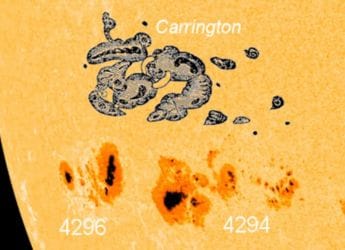- Home
- Science
- Science News
- sPHENIX Detector Clears Test to Study Quark Gluon Plasma Which Formed After the Big Bang, Claims Study
sPHENIX Detector Clears Test to Study Quark-Gluon Plasma Which Formed After the Big Bang, Claims Study
The sPHENIX detector passed calibration, paving the way to study quark-gluon plasma and unlock secrets of the early universe.

Photo Credit: Brookhaven National Laboratory
Brookhaven’s sPHENIX is ready to probe quark-gluon plasma from the early universe
A new tool has been developed by scientists to study the early universe. After passing a critical "standard candle" calibration, the sPHENIX detector at Brookhaven's Relativistic Heavy Ion Collider (RHIC) is prepared to detect the remains of quark-gluon plasma, the hot, dense "primordial soup" that flooded the universe immediately following the Big Bang. This plasma is momentarily recreated at Brookhaven's RHIC by smashing heavy gold ions at almost the speed of light. This achievement opens the door to in-depth research on these remnants of the Big Bang.
Advanced Detector Technology
According to the research, sPHENIX proved its precision by smashing gold ions at near-light speed and tallying the resulting particles. It measured head-on versus grazing collisions, finding ten times more particles (and ten times the energy) in straight-on impacts. This 'standard candle' test confirmed the detector was working as designed.
The two-story, 1,000-ton detector surrounds RHIC's beams. It can record 15,000 collisions per second, acting like a 3D camera that tracks each particle's energy and trajectory. Scientists compare it to launching a new space telescope taking its first picture, showing sPHENIX is ready for new discoveries.
Peering into the Primordial Universe
The quark-gluon plasma (QGP), a fluid of quarks and gluons that filled the early universe, is momentarily recreated by RHIC collisions. After cooling and condensing into protons and neutrons, this QGP disappears almost immediately (between 10 and 22 seconds). Only QGP's decay products, or "ashes," which sPHENIX will measure to reconstruct the plasma's properties, can be seen on their own.
Researchers intend to gain new understanding of the origin of matter by examining these particles in order to determine how dense the primordial soup was and how particles spread through it. In essence, physicists may be able to reconstruct conditions in the universe's early microseconds by dissecting these "ashes."
Get your daily dose of tech news, reviews, and insights, in under 80 characters on Gadgets 360 Turbo. Connect with fellow tech lovers on our Forum. Follow us on X, Facebook, WhatsApp, Threads and Google News for instant updates. Catch all the action on our YouTube channel.
Related Stories
- Samsung Galaxy Unpacked 2025
- ChatGPT
- Redmi Note 14 Pro+
- iPhone 16
- Apple Vision Pro
- Oneplus 12
- OnePlus Nord CE 3 Lite 5G
- iPhone 13
- Xiaomi 14 Pro
- Oppo Find N3
- Tecno Spark Go (2023)
- Realme V30
- Best Phones Under 25000
- Samsung Galaxy S24 Series
- Cryptocurrency
- iQoo 12
- Samsung Galaxy S24 Ultra
- Giottus
- Samsung Galaxy Z Flip 5
- Apple 'Scary Fast'
- Housefull 5
- GoPro Hero 12 Black Review
- Invincible Season 2
- JioGlass
- HD Ready TV
- Laptop Under 50000
- Smartwatch Under 10000
- Latest Mobile Phones
- Compare Phones
- Lava Play Max
- Poco C85 5G
- Honor Magic 8 Lite
- Jolla Phone
- Realme P4x 5G
- OnePlus Ace 6T
- Nubia Flip 3
- Nubia Fold
- Asus ProArt P16
- MacBook Pro 14-inch (M5, 2025)
- OnePlus Pad Go 2
- Poco Pad M1
- Just Corseca Skywatch Pro
- Honor Watch X5
- Acerpure Nitro Z Series 100-inch QLED TV
- Samsung 43 Inch LED Ultra HD (4K) Smart TV (UA43UE81AFULXL)
- Asus ROG Ally
- Nintendo Switch Lite
- Haier 1.6 Ton 5 Star Inverter Split AC (HSU19G-MZAID5BN-INV)
- Haier 1.6 Ton 5 Star Inverter Split AC (HSU19G-MZAIM5BN-INV)

















